201507fda行业指南:分析方法验证(中英文)(下).doc
201507FDA行业指南:分析方法验证(中英文)(下)

201507FDA行业指南:分析方法验证(中英文)(下)VII. STATISTICAL ANALYSIS AND MODELS 统计学分析和模型A. Statistics 统计学Statistical analysis of validation data can be used to evaluate validation characteristics against predetermined acceptance criteria. All statistical procedures and parameters used in the analysis of the data should be based on sound principles and appropriate for the intended evaluation. Several statistical methods are useful for assessing validation characteristics, for example, an analysis of variance (ANOVA) to assess regression analysis R (correlation coefficient) and R squared (coefficient of determination) or linear regression to measure linearity. Many statistical methods used for assessing validation characteristics rely on population normality, and it is important to determine whether or not to reject this assumption. There are many techniques, such as histograms, normality tests, and probability plots that can be used to evaluate the observed distribution. It may be appropriate to transform the data to better fit the normal distribution or apply distribution-free (nonparametric) approaches when the observed data are not normally distributed. Appropriate literature or text should be consulted for information on statistical procedures to use when developing new test methods, evaluating existing test methods or evaluating measurement system performance, as well as other general information on the interpretation and treatment of analytical data[18].The data analysis should be assured either by using appropriately validated software or independent verification for correctness.验证数据的统计学分析可以用于评估验证的属性是否符合预定的可接受标准。
FDA现场检查行业指南(中英文对照)

FDA行业指南-药品现场检查中被认为是延迟、否认、限制或拒绝的情形一、介绍2012年7月9日,《美国食品和药物管理局安全及创新法案》(FDASIA)被签署成为法律。
FDASIA章节707添加了501(j)到《食品、药品和化妆品法令》(FD&C Act),认为“任何从事生产、加工、包装或持有的生产企业、库房造成现场检查的延迟、否认、限制或拒绝的情况均被认为该产品为假劣药品”。
该指南的目的是对“延迟、否认、限制或拒绝”的情形进行定义。
二、定义1、延迟A、检查计划安排的延迟FDA将会根据当地的情况对检查计划进行适当的调整,例如天气、安保、节假日、其他非工作日、企业的生产计划等。
以下延迟的情况将会被认为产品是假劣药品,包括但不仅限于:●企业不同意建议的检查日期,但没有合理的解释。
●在检查安排后,企业要求延迟检查日期,但没有合理的解释。
●企业不能回答为什么FDA联系不上企业指定的联系人。
下面给出了将不会被认为是假劣药品的潜在合理解释的一个例子,但不仅限于:●企业没有正在生产,例如每个月只生产一次,企业要求检查日期另定,以便FDA检查时生产正在进行中。
B、检查期间的延迟以下检查期间的延迟情况将会被认为产品是假劣药品,包括但不仅限于:●企业不允许FDA检查官进入某个区域直至一段时间过去之后,即使这个区域是正在进行操作的并且是FDA有权检查的区域,对于这种行为没有合理的解释。
●企业长时间把FDA检查官单独撂在会议室,没有相应的文件或责任人供审查和询问,从而干扰检查官完成其相应的检查。
下面给出了将不会被认为是假劣药品的潜在合理解释的一个例子,但不仅限于:●企业不允许FDA检查官进入无菌工艺区域,直至检查官能满足企业的无菌更衣程序要求。
C、记录提供延迟以下记录提供延迟的情况将会被认为产品是假劣药品,包括但不仅限于:●在检查期间,FDA检查官要求在合理的时间内提供其有权查看的文件和记录,但是企业不能按时提供,且没有合理的解释。
美国FDA 分析方法验证指南
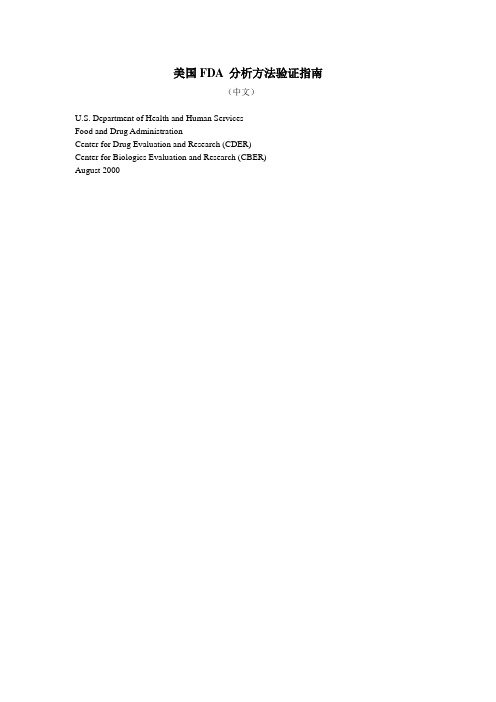
美国FDA 分析方法验证指南(中文)U.S. Department of Health and Human ServicesFood and Drug AdministrationCenter for Drug Evaluation and Research (CDER)Center for Biologics Evaluation and Research (CBER)August 2000目录一、结论………………………………………………………..…………………二、背景……………………………………………………………..……….…..三、分析方法的类型…………………………………………………………….A. 法定分析方法……………………………………………………………B. 替代分析方法……………………………………………………………C. 稳定性指示分析…………………………………………………………四、标准品……………………………………………………………………….. A.标准品的类型……………………………………………………………B.分析报告单………………………………………………………………C.标准品的界定……………………………………………………………五、IND 中的分析方法验证……………………………………………………..六、NDA、ANDA、BLA 和PLA 中分析方法的内容和格式…………………A.基本方法…………………………………………………………………B.取样………………………………………………………………………C.仪器和仪器参数…………………………………………………………. D.试剂………………………………………………………………………E.系统适应性实验…………………………………………………………. F.标准品的制备……………………………………………………………..G.操作过程…………………………………………………………………….H.操作程序……………………………………………………………………I.计算…………………………………………………………………………J.结果报告……………………………………………………………………. 1.通则……………………………………………………………………2.杂质分析规程…………………………………………………………七、NDA,ANDA,BLA 和PLA 中的分析方法验证………………………….. A.非药典分析方法…………………………………………………………1. 验证项目……………………………………………………………2. 其它验证资料……………………………………………………….(1) 讨论可能会形成的异构体并讨论异构体的控制…………………..a. 耐用性…………………………………………………….b. 强降解实验………………………………………………c.仪器输出/原始资料………………………………………i. 有机杂质……………………………………………ii. 原料药……………………………………………….iii. 制剂………………………………………………….(2) 各类检测的推荐验证项目…………………………………………..a. 鉴别………………………………………………………....b. 杂质………………………………………………………..c. 含量………………………………………………………..d. 特定实验…………………………………………………….B.药典分析方法(21CFR 211.194(a)(2))…………………………………..八. 统计分析…………………………………………………………………….A.基本原则………………………………………………………………B:对比研究…………………………………………………………………C:统计………………………………………………………………………九、再验证………………………………………………………………………十、分析方法验证资料:内容和数据处理…………………………………….A.分析方法验证资料…………………………………………………….B:样品的选择和运输…………………………………………………….C:各方职责……………………………………………………………….1.申请人……………………………………………………………….2.化学评审官………………………………………………………….3.FDA 实验室………………………………………………………….4.检查官……………………………………………………………….十一、方法学……………………………………………………………………A.高效液相色谱(HPLC)………………………………………………….1.色谱柱……………………………………………………………….2.系统适应性研究…………………………………………………….3.操作参数…………………………………………………………….B.气相色谱(GC)………………………………………………………….1.色谱柱……………………………………………………………….2.操作参数……………………………………………………………..3.系统适应性实验……………………………………………………..C:分光光度法,光谱法和相关的物理方法………………………………D:毛细管电泳(CE)…………………………………………………………E:旋光度……………………………………………………………………F:和粒径分析相关的分析方法……………………………………………G:溶出度…………………………………………………………………..H:其它仪器分析方法………………………………………………………附录A……………………………………………………………………………….. 附录B……………………………………………………………………………….. 术语表……………………………………………………………………………….一、绪论本指南旨在为申请者提供建议,以帮助其提交分析方法,方法验证资料和样品用于支持原料药和制剂的认定,剂量,质量,纯度和效力方面的文件。
FDA指南中文版

目录表I. 导言 (1)II. 背景 (2)III. 分析方法的类型 (3)A. 法定分析方法 (3)B. 可选择分析方法 (3)3 C. 稳定性指示分析 (3)IV. 对照品 (4)A. 对照品的类型 (4)B. 分析报告单 (4)C. 对照品的界定 (4)V. IND中的分析方法验证 (6)VI. NDA, ANDA, BLA 和PLA中分析方法验证的内容和格式 (6)A. 原则 (6)B. 取样 (7)C. 仪器和仪器参数 (7)D. 试剂 (7)E. 系统适应性实验 (7)F. 对照品的制备 (7)G. 样品的制备 (8)H. 分析方法 (8)L. 计算 (8)J. 结果报告 (8)VII. NDA,ANDA,BLA和PLA中的分析方法验证 (9)A. 非法定分析方法 (9)1.验证项目 (9)2. 其它分析方法验证信息 (10)a. 耐用性 (11)b. 强降解实验 (11)c. 仪器输出/原始资料 (11)3.各类检测的建议验证项目 (13)B. 法定分析方法 (15)VIII. 统计分析 (15)A. 总则 (15)B. 比较研究 (16)C. 统计 (16)IX. 再验证 (16)X. 分析方法验证技术包:内容和过程 (17)A. 分析方法验证技术包 (17)B. 样品的选择和运输 (18)C. 各方责任 (19)XI. 方法 (20)A. 高效液相色谱(HPLC) (20)B. 气相色谱(GC) (22)C. 分光光度法,光谱学,光谱法和相关的物理方法 (23)D. 毛细管电泳 (23)E. 旋光度 (24)F. 粒径相关的分析方法 (25)G. 溶出度 (26)H. 其它仪器分析方法 (27)附件 A:NDA,ANDA,BLA和PLA申请的内容 (28)附件 B:分析方法验证的问题和延误 (29)参考文献 (30)术语表 (32)I. INTRODUCTIONThis guidance provides recommendations to applicants on submitting analyticalprocedures, validation data, and samples to support the documentation of the identity, strength, quality, purity, and potency of drug substances and drug products.1. 绪论本指南旨在为申请者提供建议,以帮助其提交分析方法,方法验证资料和样品用于支持原料药和制剂的认定,剂量,质量,纯度和效力方面的文件。
FDA指南中文版

目录表I. 导言 (1)II. 背景 (2)III. 分析方法的类型 (3)A. 法定分析方法 (3)B. 可选择分析方法 (3)3 C. 稳定性指示分析 (3)IV. 对照品 (4)A. 对照品的类型 (4)B. 分析报告单 (4)C. 对照品的界定 (4)V. IND中的分析方法验证 (6)VI. NDA, ANDA, BLA 和PLA中分析方法验证的内容和格式 (6)A. 原则 (6)B. 取样 (7)C. 仪器和仪器参数 (7)D. 试剂 (7)E. 系统适应性实验 (7)F. 对照品的制备 (7)G. 样品的制备 (8)H. 分析方法 (8)L. 计算 (8)J. 结果报告 (8)VII. NDA,ANDA,BLA和PLA中的分析方法验证 (9)A. 非法定分析方法 (9)1.验证项目 (9)2. 其它分析方法验证信息 (10)a. 耐用性 (11)b. 强降解实验 (11)c. 仪器输出/原始资料 (11)3.各类检测的建议验证项目 (13)B. 法定分析方法 (15)VIII. 统计分析 (15)A. 总则 (15)B. 比较研究 (16)C. 统计 (16)IX. 再验证 (16)X. 分析方法验证技术包:内容和过程 (17)A. 分析方法验证技术包 (17)B. 样品的选择和运输 (18)C. 各方责任 (19)XI. 方法 (20)A. 高效液相色谱(HPLC) (20)B. 气相色谱(GC) (22)C. 分光光度法,光谱学,光谱法和相关的物理方法 (23)D. 毛细管电泳 (23)E. 旋光度 (24)F. 粒径相关的分析方法 (25)G. 溶出度 (26)H. 其它仪器分析方法 (27)附件 A:NDA,ANDA,BLA和PLA申请的内容 (28)附件 B:分析方法验证的问题和延误 (29)参考文献 (30)术语表 (32)I. INTRODUCTIONThis guidance provides recommendations to applicants on submitting analyticalprocedures, validation data, and samples to support the documentation of the identity, strength, quality, purity, and potency of drug substances and drug products.1. 绪论本指南旨在为申请者提供建议,以帮助其提交分析方法,方法验证资料和样品用于支持原料药和制剂的认定,剂量,质量,纯度和效力方面的文件。
美国FDA药物分析程序及方法验证指导原则(中文版)
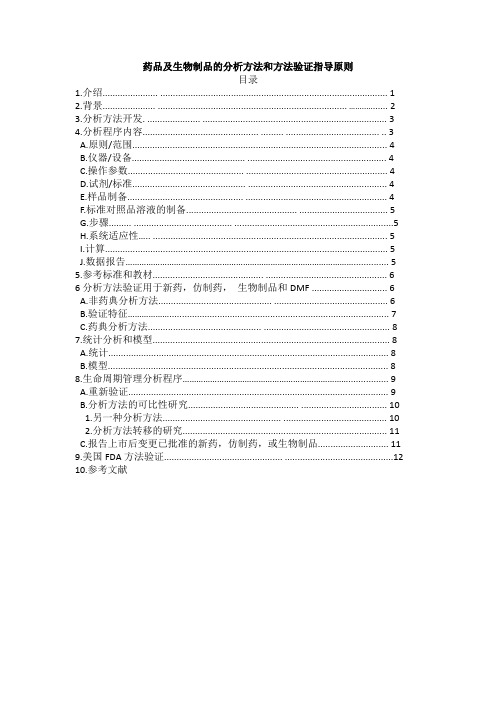
药品及生物制品的分析方法和方法验证指导原则目录1.介绍...................... (1)2.背景..................... .. (2)3.分析方法开发. ..................... . (3)4.分析程序内容.............................................. ......... ..................................... .. 3A.原则/范围 (4)B.仪器/设备............................................. . (4)C.操作参数.............................................. .. (4)D.试剂/标准............................................. . (4)E.样品制备.............................................. .. (4)F.标准对照品溶液的制备............................................ .. (5)G.步骤......... ....................................... (5)H.系统适应性..... (5)I.计算 (5)J.数据报告 (5)5.参考标准和教材............................................ (6)6分析方法验证用于新药,仿制药,生物制品和DMF (6)A.非药典分析方法............................................. (6)B.验证特征 (7)C.药典分析方法............................................. .. (8)7.统计分析和模型 (8)A.统计 (8)B.模型 (8)8.生命周期管理分析程序 (9)A.重新验证 (9)B.分析方法的可比性研究............................................ . (10)1.另一种分析方法............................................... .. (10)2.分析方法转移的研究 (11)C.报告上市后变更已批准的新药,仿制药,或生物制品 (11)9.美国FDA方法验证............................................... . (12)10.参考文献前言本指导原则草案,定稿后,将代表美国食品和药物管理局(FDA)目前关于这个话题目前的想法。
201507FDA行业指南:分析方法验证(中英文)(上)

201507FDA行业指南:分析方法验证(中英文)(上)Analytical Procedures and Methods Validation for Drugs and Biologics药品和生物制品分析方法验证Guidance for Industry行业指南U.S. Department of Health and Human ServicesFood and Drug AdministrationCenter for Drug Evaluation and Research (CDER)Center for Biologics Evaluation and Research (CBER)July 2015Pharmaceutical Quality/CMCAnalytical Procedures and Methods Validation for Drugs and BiologicsGuidance for IndustryAdditional copies are available from:Office of Communications, Division of Drug InformationCenter for Drug Evaluation and ResearchFood and Drug Administration10001 New Hampshire Ave., Hillandale Bldg., 4th FloorSilver Spring, MD 20993Phone: 855-543-3784 or 301-796-3400; Fax: 301-431-6353 Email:****************.gov/Drugs/GuidanceComplianceRegulatoryInformation/Guidan ces/default.htmand/orOffice of Communication, Outreach and DevelopmentCenter for Biologics Evaluation and ResearchFood and Drug Administration10903 New Hampshire Ave., Bldg. 71, Room 3128Silver Spring, MD 20993Phone: 800-835-4709 or 240-402-7800Email:************.gov/BiologicsBloodVaccines/GuidanceComplianceRegulatoryInf ormation/Guidances/default.htmU.S. Department of Health and Human ServicesFood and Drug AdministrationCenter for Drug Evaluation and Research (CDER)Center for Biologics Evaluation and Research (CBER)July 2015Pharmaceutical Quality/CMCAnalytical Procedures and Methods Validation for Drugs and Biologics药物和生物制品分析方法验证Guidance for Industry[1]行业指南This guidance represents the current thinking of the Food and Drug Administration (FDA or Agency) on this topic. It does not create any rights for any person and is not binding on FDA or the public. You can use an alternative approach if it satisfies the requirements of the applicable statutes and regulations. To discuss an alternative approach, contact the FDA staff responsible for this guidance as listed on the title page.本指南代表了FDA对本专题的当前想法。
FDA 行业指南 中英对照 待完成
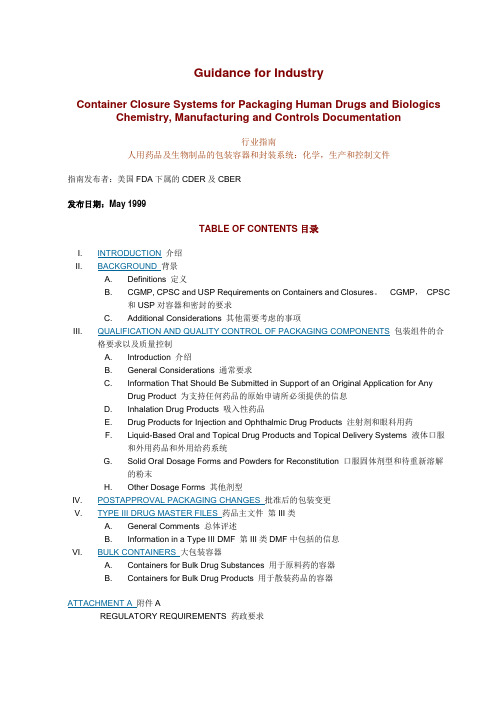
Guidance for IndustryContainer Closure Systems for Packaging Human Drugs and Biologics Chemistry, Manufacturing and Controls Documentation行业指南人用药品及生物制品的包装容器和封装系统:化学,生产和控制文件指南发布者:美国FDA下属的CDER及CBER发布日期:May 1999TABLE OF CONTENTS目录I. INTRODUCTION介绍II. BACKGROUND 背景A. Definitions 定义B. CGMP, CPSC and USP Requirements on Containers and Closures。
CGMP,CPSC和USP对容器和密封的要求C. Additional Considerations 其他需要考虑的事项III. QUALIFICATION AND QUALITY CONTROL OF PACKAGING COMPONENTS包装组件的合格要求以及质量控制A. Introduction 介绍B. General Considerations 通常要求C. Information That Should Be Submitted in Support of an Original Application for AnyDrug Product 为支持任何药品的原始申请所必须提供的信息D. Inhalation Drug Products 吸入性药品E. Drug Products for Injection and Ophthalmic Drug Products 注射剂和眼科用药F. Liquid-Based Oral and Topical Drug Products and Topical Delivery Systems 液体口服和外用药品和外用给药系统G. Solid Oral Dosage Forms and Powders for Reconstitution 口服固体剂型和待重新溶解的粉末H. Other Dosage Forms 其他剂型IV. POSTAPPROVAL PACKAGING CHANGES 批准后的包装变更V. TYPE III DRUG MASTER FILES 药品主文件第III类A. General Comments 总体评述B. Information in a Type III DMF 第III类DMF中包括的信息VI. BULK CONTAINERS 大包装容器A. Containers for Bulk Drug Substances 用于原料药的容器B. Containers for Bulk Drug Products 用于散装药品的容器ATTACHMENT A 附件AREGULATORY REQUIREMENTS 药政要求ATTACHMENT B 附件BCOMPLIANCE POLICY GUIDES THAT CONCERN PACKAGING 关于包装,所适用的政策指南ATTACHMENT C 附件CEXTRACTION STUDIES “提取性"研究ATTACHMENT D 附件DABBREVIATIONS 缩略语ATTACHMENT E 附件EREFERENCES 参考文献GUIDANCE FOR INDUSTRY1Container Closure Systems for Packaging Human Drugs and Biologics Chemistry, Manufacturing and Controls DocumentationI.INTRODUCTION介绍This document is intended to provide guidance on general principles2 for submitting information on packaging materials used for human drugs and biologics。
美国FDA分析方法验证指南中英文对照--6
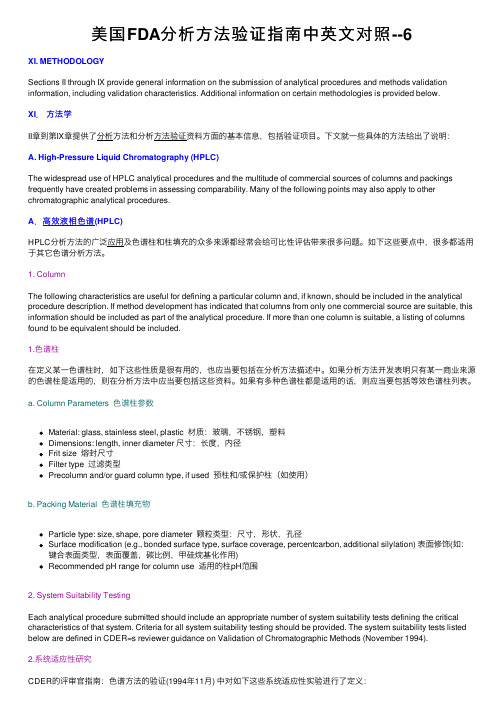
美国FDA分析⽅法验证指南中英⽂对照--6XI. METHODOLOGYSections II through IX provide general information on the submission of analytical procedures and methods validation information, including validation characteristics. Additional information on certain methodologies is provided below.XI.⽅法学II章到第IX章提供了分析⽅法和分析⽅法验证资料⽅⾯的基本信息,包括验证项⽬。
下⽂就⼀些具体的⽅法给出了说明:A. High-Pressure Liquid Chromatography (HPLC)The widespread use of HPLC analytical procedures and the multitude of commercial sources of columns and packings frequently have created problems in assessing comparability. Many of the following points may also apply to other chromatographic analytical procedures.⾊谱(HPLC)⾼效液相⾊谱A.⾼效液相HPLC分析⽅法的⼴泛应⽤及⾊谱柱和柱填充的众多来源都经常会给可⽐性评估带来很多问题。
如下这些要点中,很多都适⽤于其它⾊谱分析⽅法。
1. ColumnThe following characteristics are useful for defining a particular column and, if known, should be included in the analytical procedure description. If method development has indicated that columns from only one commercial source are suitable, this information should be included as part of the analytical procedure. If more than one column is suitable, a listing of columns found to be equivalent should be included.1.⾊谱柱在定义某⼀⾊谱柱时,如下这些性质是很有⽤的,也应当要包括在分析⽅法描述中。
美国FDA分析方法验证指南中英文对照.doc
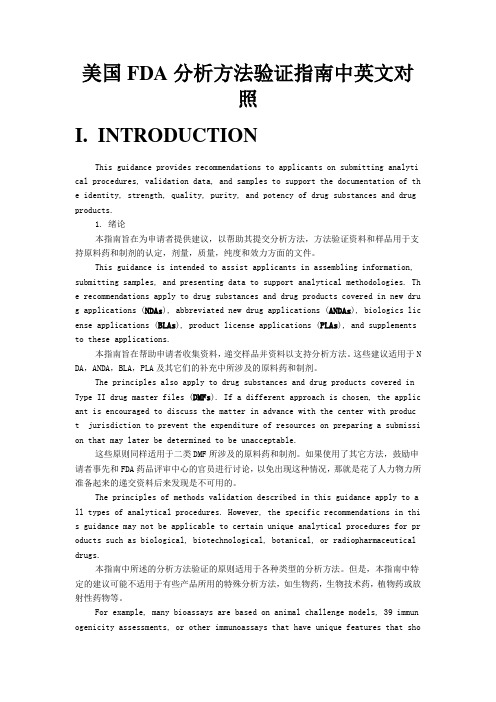
美国FDA分析方法验证指南中英文对照I. INTRODUCTIONThis guidance provides recommendations to applicants on submitting analyti cal procedures, validation data, and samples to support the documentation of th e identity, strength, quality, purity, and potency of drug substances and drug products.1. 绪论本指南旨在为申请者提供建议,以帮助其提交分析方法,方法验证资料和样品用于支持原料药和制剂的认定,剂量,质量,纯度和效力方面的文件。
This guidance is intended to assist applicants in assembling information, submitting samples, and presenting data to support analytical methodologies. Th e recommendations apply to drug substances and drug products covered in new dru g applications (NDAs), abbreviated new drug applications (ANDAs), biologics lic ense applications (BLAs), product license applications (PLAs), and supplements to these applications.本指南旨在帮助申请者收集资料,递交样品并资料以支持分析方法。
这些建议适用于N DA,ANDA,BLA,PLA及其它们的补充中所涉及的原料药和制剂。
201507fda行业指南:分析方法验证(中英文)(下)
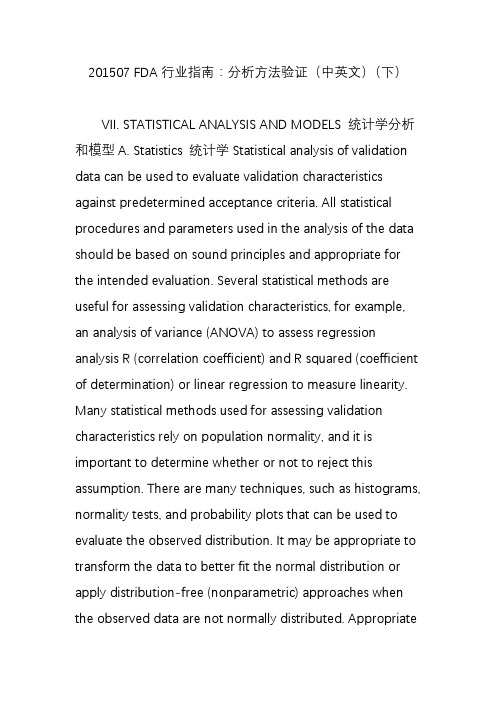
201507 FDA行业指南:分析方法验证(中英文)(下)VII. STATISTICAL ANALYSIS AND MODELS 统计学分析和模型A. Statistics 统计学Statistical analysis of validation data can be used to evaluate validation characteristics against predetermined acceptance criteria. All statistical procedures and parameters used in the analysis of the data should be based on sound principles and appropriate for the intended evaluation. Several statistical methods are useful for assessing validation characteristics, for example, an analysis of variance (ANOVA) to assess regression analysis R (correlation coefficient) and R squared (coefficient of determination) or linear regression to measure linearity. Many statistical methods used for assessing validation characteristics rely on population normality, and it is important to determine whether or not to reject this assumption. There are many techniques, such as histograms, normality tests, and probability plots that can be used to evaluate the observed distribution. It may be appropriate to transform the data to better fit the normal distribution or apply distribution-free (nonparametric) approaches when the observed data are not normally distributed. Appropriateliterature or text should be consulted for information on statistical procedures to use when developing new test methods, evaluating existing test methods or evaluating measurement system performance, as well as other general information on the interpretation and treatment of analytical data[18].The data analysis should be assured either by using appropriately validated software or independent verification for correctness.验证数据的统计学分析可以用于评估验证的属性是否符合预定的可接受标准。
FDA行业指南中英对照待完成
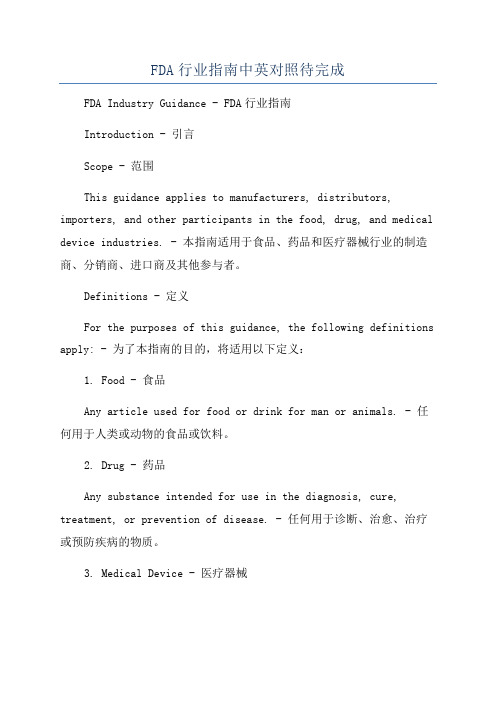
FDA行业指南中英对照待完成FDA Industry Guidance - FDA行业指南Introduction - 引言Scope - 范围This guidance applies to manufacturers, distributors, importers, and other participants in the food, drug, and medical device industries. - 本指南适用于食品、药品和医疗器械行业的制造商、分销商、进口商及其他参与者。
Definitions - 定义For the purposes of this guidance, the following definitions apply: - 为了本指南的目的,将适用以下定义:1. Food - 食品Any article used for food or drink for man or animals. - 任何用于人类或动物的食品或饮料。
2. Drug - 药品Any substance intended for use in the diagnosis, cure, treatment, or prevention of disease. - 任何用于诊断、治愈、治疗或预防疾病的物质。
3. Medical Device - 医疗器械Any instrument, apparatus, or device intended for use in the diagnosis, cure, mitigation, treatment, or prevention of disease. - 任何用于诊断、治愈、缓解、治疗或预防疾病的仪器、装置或设备。
4. Manufacturer - 制造商Product Quality Requirements - 产品质量要求Manufacturers should ensure that products meet the appropriate quality standards established by the FDA. - 制造商应确保产品符合FDA制定的适当质量标准。
201507FDA行业指南分析方法验证

201507FDA行业指南分析方法验证2015年7月,美国FDA (Food and Drug Administration) 发布了新的行业指南,介绍了药物和医疗器械领域的分析方法验证。
这个指南对于保证产品质量和确保公众安全具有重要意义。
本文将对该指南进行分析,并探讨其对行业的影响以及验证方法的重要性。
1. 简介验证是确保分析方法在实际使用中可靠有效的过程。
FDA的行业指南旨在为制药和医疗器械公司提供明确的准则,以确保他们的分析方法能够满足质量控制和监管要求。
这些准则适用于各种不同类型的分析方法,包括物理、化学、生物和微生物学方法。
2. 指南内容概述行业指南详细说明了验证过程的各个方面,包括确定适用性、验证方案、系统准备、执行验证、结果分析和文档记录等。
其中,关键的几个步骤将在下文中详细探讨。
3. 确定适用性在验证方法之前,首先需要确定该方法是否适用于特定的产品或测试要求。
这包括评估方法的准确性、灵敏度、特异性和稳定性。
通过这样的评估,可以确定方法是否足够可靠来提供准确的测试结果。
4. 验证方案验证方案是验证过程的蓝图,包括验证目标、测试范围、验证样品和测试计划等。
在制定验证方案时,需要考虑产品的特点、使用环境和监管要求。
一个详细而全面的验证方案可以确保全面有效地验证分析方法。
5. 系统准备在进行验证之前,需要确保验证所需的系统和设备处于适当的状态。
这包括系统的校准、验证设备的合格以及操作程序的准备等。
只有在系统准备充分的情况下,才能确保验证结果的准确性和可靠性。
6. 执行验证执行验证是验证过程的核心步骤。
这涉及到按照预定的方法和程序进行一系列测试,并记录结果。
测试的过程中需要注意各种潜在的干扰因素,如环境影响、操作人员技能和设备性能等。
7. 结果分析验证的结果需要进行详细的分析和评估。
这包括比较验证结果与预期结果,评估方法的准确性和可靠性,并确定是否需要进行进一步的调整或改进。
结果分析是验证过程结束后的一个重要环节,它为后续的质量控制和监管提供了重要的依据。
201507FDA行业指南:分析方法验证(中英文)(中)
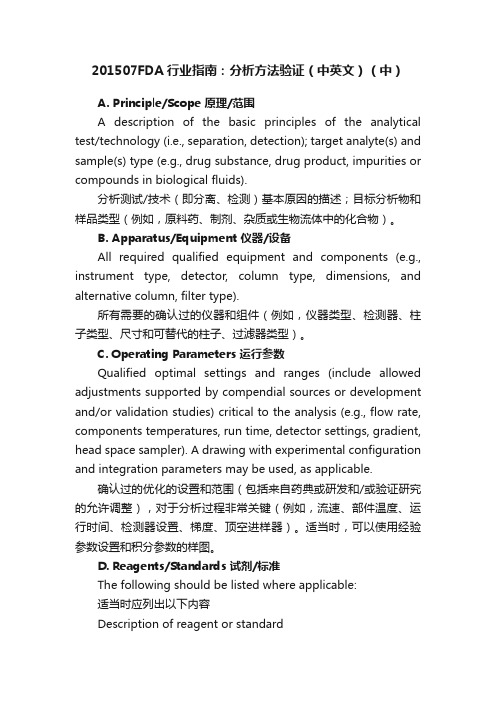
201507FDA行业指南:分析方法验证(中英文)(中)A. Principle/Scope 原理/范围A description of the basic principles of the analytical test/technology (i.e., separation, detection); target analyte(s) and sample(s) type (e.g., drug substance, drug product, impurities or compounds in biological fluids).分析测试/技术(即分离、检测)基本原因的描述;目标分析物和样品类型(例如,原料药、制剂、杂质或生物流体中的化合物)。
B. Apparatus/Equipment 仪器/设备All required qualified equipment and components (e.g., instrument type, detector, column type, dimensions, and alternative column, filter type).所有需要的确认过的仪器和组件(例如,仪器类型、检测器、柱子类型、尺寸和可替代的柱子、过滤器类型)。
C. Operating Parameters 运行参数Qualified optimal settings and ranges (include allowed adjustments supported by compendial sources or development and/or validation studies) critical to the analysis (e.g., flow rate, components temperatures, run time, detector settings, gradient, head space sampler). A drawing with experimental configuration and integration parameters may be used, as applicable.确认过的优化的设置和范围(包括来自药典或研发和/或验证研究的允许调整),对于分析过程非常关键(例如,流速、部件温度、运行时间、检测器设置、梯度、顶空进样器)。
美国fda分析方法验证指南
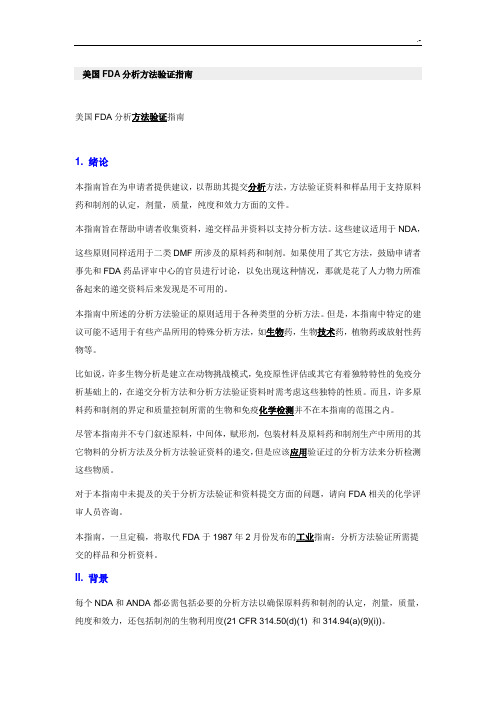
美国FDA分析方法验证指南美国FDA分析方法验证指南1. 绪论本指南旨在为申请者提供建议,以帮助其提交分析方法,方法验证资料和样品用于支持原料药和制剂的认定,剂量,质量,纯度和效力方面的文件。
本指南旨在帮助申请者收集资料,递交样品并资料以支持分析方法。
这些建议适用于NDA,这些原则同样适用于二类DMF所涉及的原料药和制剂。
如果使用了其它方法,鼓励申请者事先和FDA药品评审中心的官员进行讨论,以免出现这种情况,那就是花了人力物力所准备起来的递交资料后来发现是不可用的。
本指南中所述的分析方法验证的原则适用于各种类型的分析方法。
但是,本指南中特定的建议可能不适用于有些产品所用的特殊分析方法,如生物药,生物技术药,植物药或放射性药物等。
比如说,许多生物分析是建立在动物挑战模式,免疫原性评估或其它有着独特特性的免疫分析基础上的,在递交分析方法和分析方法验证资料时需考虑这些独特的性质。
而且,许多原料药和制剂的界定和质量控制所需的生物和免疫化学检测并不在本指南的范围之内。
尽管本指南并不专门叙述原料,中间体,赋形剂,包装材料及原料药和制剂生产中所用的其它物料的分析方法及分析方法验证资料的递交,但是应该应用验证过的分析方法来分析检测这些物质。
对于本指南中未提及的关于分析方法验证和资料提交方面的问题,请向FDA相关的化学评审人员咨询。
本指南,一旦定稿,将取代FDA于1987年2月份发布的工业指南:分析方法验证所需提交的样品和分析资料。
II. 背景每个NDA和ANDA都必需包括必要的分析方法以确保原料药和制剂的认定,剂量,质量,纯度和效力,还包括制剂的生物利用度(21 CFR 314.50(d)(1) 和314.94(a)(9)(i))。
FDA验证文件现场备查,可以不与DMF一起交。
必须要有资料来论证所用的分析方法是符合一定的准确度和可靠性标准的。
分析方法验证是论证某一分析方法适用于其用途的过程。
分析方法的验证过程是从申请者有计划地系统性收集验证资料以支持分析方法开始的。
美国FDA 分析方法验证指南

美国FDA 分析方法验证指南(中文)U.S. Department of Health and Human ServicesFood and Drug AdministrationCenter for Drug Evaluation and Research (CDER)Center for Biologics Evaluation and Research (CBER)August 2000目录一、结论………………………………………………………..…………………二、背景……………………………………………………………..……….…..三、分析方法的类型…………………………………………………………….A. 法定分析方法……………………………………………………………B. 替代分析方法……………………………………………………………C. 稳定性指示分析…………………………………………………………四、标准品……………………………………………………………………….. A.标准品的类型……………………………………………………………B.分析报告单………………………………………………………………C.标准品的界定……………………………………………………………五、IND 中的分析方法验证……………………………………………………..六、NDA、ANDA、BLA 和PLA 中分析方法的内容和格式…………………A.基本方法…………………………………………………………………B.取样………………………………………………………………………C.仪器和仪器参数…………………………………………………………. D.试剂………………………………………………………………………E.系统适应性实验…………………………………………………………. F.标准品的制备……………………………………………………………..G.操作过程…………………………………………………………………….H.操作程序……………………………………………………………………I.计算…………………………………………………………………………J.结果报告……………………………………………………………………. 1.通则……………………………………………………………………2.杂质分析规程…………………………………………………………七、NDA,ANDA,BLA 和PLA 中的分析方法验证………………………….. A.非药典分析方法…………………………………………………………1. 验证项目……………………………………………………………2. 其它验证资料……………………………………………………….(1) 讨论可能会形成的异构体并讨论异构体的控制…………………..a. 耐用性…………………………………………………….b. 强降解实验………………………………………………c.仪器输出/原始资料………………………………………i. 有机杂质……………………………………………ii. 原料药……………………………………………….iii. 制剂………………………………………………….(2) 各类检测的推荐验证项目…………………………………………..a. 鉴别………………………………………………………....b. 杂质………………………………………………………..c. 含量………………………………………………………..d. 特定实验…………………………………………………….B.药典分析方法(21CFR 211.194(a)(2))…………………………………..八. 统计分析…………………………………………………………………….A.基本原则………………………………………………………………B:对比研究…………………………………………………………………C:统计………………………………………………………………………九、再验证………………………………………………………………………十、分析方法验证资料:内容和数据处理…………………………………….A.分析方法验证资料…………………………………………………….B:样品的选择和运输…………………………………………………….C:各方职责……………………………………………………………….1.申请人……………………………………………………………….2.化学评审官………………………………………………………….3.FDA 实验室………………………………………………………….4.检查官……………………………………………………………….十一、方法学……………………………………………………………………A.高效液相色谱(HPLC)………………………………………………….1.色谱柱……………………………………………………………….2.系统适应性研究…………………………………………………….3.操作参数…………………………………………………………….B.气相色谱(GC)………………………………………………………….1.色谱柱……………………………………………………………….2.操作参数……………………………………………………………..3.系统适应性实验……………………………………………………..C:分光光度法,光谱法和相关的物理方法………………………………D:毛细管电泳(CE)…………………………………………………………E:旋光度……………………………………………………………………F:和粒径分析相关的分析方法……………………………………………G:溶出度…………………………………………………………………..H:其它仪器分析方法………………………………………………………附录A……………………………………………………………………………….. 附录B……………………………………………………………………………….. 术语表……………………………………………………………………………….一、绪论本指南旨在为申请者提供建议,以帮助其提交分析方法,方法验证资料和样品用于支持原料药和制剂的认定,剂量,质量,纯度和效力方面的文件。
FDA分析方法验证指南
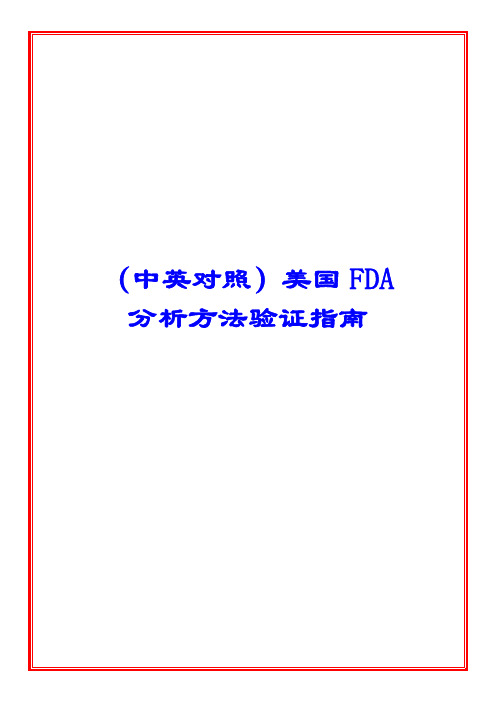
(中英对照)美国FDA 分析方法验证指南目 录1.绪论 (4)II.背景 (5)III.分析方法的类型 (7)A. 法定分析方法 (7)B. 替代分析方法 (7)C. 稳定性指示分析 (8)IV 标准品 (8)A.标准品的类型 (8)B.分析报告单 (9)C.标准品的界定 (9)V.IND中的分析方法验证 (11)VI.NDA,ANDA,BLA和PLA中分析方法的内容和格式 (12)A.基本方法 (12)B.取样 (12)C.仪器和仪器参数 (12)D.试剂 (13)E.系统适应性实验 (13)F.标准品的制备 (14)H.操作过程 (14)J.计算 (14)K.结果报告 (14)VII.NDA,ANDA,BLA和PLA中的分析方法验证 (16)A.非药典分析方法 (16)1)验证项目 (16)2)其它分析方法验证信息 (17)a.耐用性 (18)b.强降解实验 (19)c.仪器输出/原始资料 (19)3)各类检测的推荐验证项目 (21)B.药典分析方法 (24)VIII.统计分析 (25)A.基本原则 (25)B.对比研究 (25)C.统计 (25)IX.再验证 (26)X.分析方法验证资料:内容和数据处理 (27)A.分析方法验证资料 (27)B.样品的选择和运输 (29)C.各方职责 (30)XI.方法学 (32)A.高效液相色谱(HPLC) (32)B.气相色谱(GC) (35)C.分光光度法,光谱法和相关的物理方法 (37)D.毛细管电泳(CE) (37)E.旋光度 (39)F.粒径分析相关的分析方法 (40)G.溶出度 (41)H.其它仪器分析方法 (43)附录A NDA, ANDA, BLA 和PLA申请的内容 (44)附录B 析方法验证的问题和延误 (45)参考文献 (46)术语表 (48)I. INTRODUCTIONThis guidance provides recommendations to applicants on submitting analytical procedures, validation data, and samples to support the documentation of the identity, strength, quality, purity, and potency of drug substances and drug products.1.绪论本指南旨在为申请者提供建议,以帮助其提交分析方法,方法验证资料和样品用于支持原料药和制剂的认定,剂量,质量,纯度和效力方面的文件。
FDA分析方法验证指南
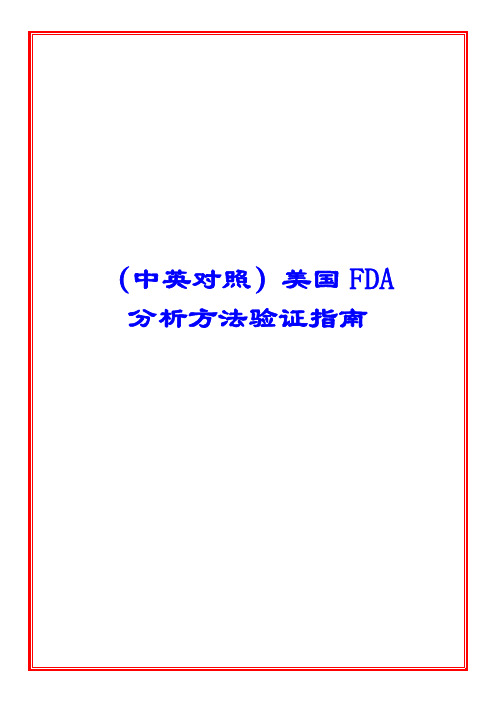
(中英对照)美国FDA 分析方法验证指南目 录1.绪论 (4)II.背景 (5)III.分析方法的类型 (7)A. 法定分析方法 (7)B. 替代分析方法 (7)C. 稳定性指示分析 (8)IV 标准品 (8)A.标准品的类型 (8)B.分析报告单 (9)C.标准品的界定 (9)V.IND中的分析方法验证 (11)VI.NDA,ANDA,BLA和PLA中分析方法的内容和格式 (12)A.基本方法 (12)B.取样 (12)C.仪器和仪器参数 (12)D.试剂 (13)E.系统适应性实验 (13)F.标准品的制备 (14)H.操作过程 (14)J.计算 (14)K.结果报告 (14)VII.NDA,ANDA,BLA和PLA中的分析方法验证 (16)A.非药典分析方法 (16)1)验证项目 (16)2)其它分析方法验证信息 (17)a.耐用性 (18)b.强降解实验 (19)c.仪器输出/原始资料 (19)3)各类检测的推荐验证项目 (21)B.药典分析方法 (24)VIII.统计分析 (25)A.基本原则 (25)B.对比研究 (25)C.统计 (25)IX.再验证 (26)X.分析方法验证资料:内容和数据处理 (27)A.分析方法验证资料 (27)B.样品的选择和运输 (29)C.各方职责 (30)XI.方法学 (32)A.高效液相色谱(HPLC) (32)B.气相色谱(GC) (35)C.分光光度法,光谱法和相关的物理方法 (37)D.毛细管电泳(CE) (37)E.旋光度 (39)F.粒径分析相关的分析方法 (40)G.溶出度 (41)H.其它仪器分析方法 (43)附录A NDA, ANDA, BLA 和PLA申请的内容 (44)附录B 析方法验证的问题和延误 (45)参考文献 (46)术语表 (48)I. INTRODUCTIONThis guidance provides recommendations to applicants on submitting analytical procedures, validation data, and samples to support the documentation of the identity, strength, quality, purity, and potency of drug substances and drug products.1.绪论本指南旨在为申请者提供建议,以帮助其提交分析方法,方法验证资料和样品用于支持原料药和制剂的认定,剂量,质量,纯度和效力方面的文件。
201507FDA行业指南:分析方法验证(中英文)(上)
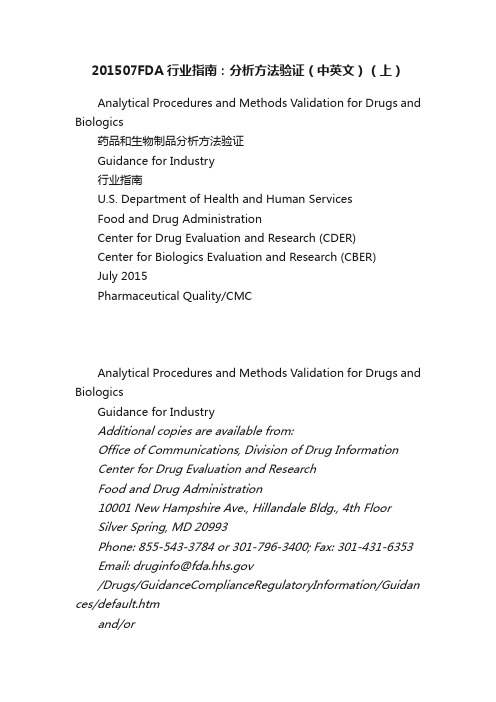
201507FDA行业指南:分析方法验证(中英文)(上)Analytical Procedures and Methods Validation for Drugs and Biologics药品和生物制品分析方法验证Guidance for Industry行业指南U.S. Department of Health and Human ServicesFood and Drug AdministrationCenter for Drug Evaluation and Research (CDER)Center for Biologics Evaluation and Research (CBER)July 2015Pharmaceutical Quality/CMCAnalytical Procedures and Methods Validation for Drugs and BiologicsGuidance for IndustryAdditional copies are available from:Office of Communications, Division of Drug InformationCenter for Drug Evaluation and ResearchFood and Drug Administration10001 New Hampshire Ave., Hillandale Bldg., 4th FloorSilver Spring, MD 20993Phone: 855-543-3784 or 301-796-3400; Fax: 301-431-6353 Email:****************.gov/Drugs/GuidanceComplianceRegulatoryInformation/Guidan ces/default.htmand/orOffice of Communication, Outreach and DevelopmentCenter for Biologics Evaluation and ResearchFood and Drug Administration10903 New Hampshire Ave., Bldg. 71, Room 3128Silver Spring, MD 20993Phone: 800-835-4709 or 240-402-7800Email:************.gov/BiologicsBloodVaccines/GuidanceComplianceRegulatoryInf ormation/Guidances/default.htmU.S. Department of Health and Human ServicesFood and Drug AdministrationCenter for Drug Evaluation and Research (CDER)Center for Biologics Evaluation and Research (CBER)July 2015Pharmaceutical Quality/CMCAnalytical Procedures and Methods Validation for Drugs and Biologics药物和生物制品分析方法验证Guidance for Industry[1]行业指南This guidance represents the current thinking of the Food and Drug Administration (FDA or Agency) on this topic. It does not create any rights for any person and is not binding on FDA or the public. You can use an alternative approach if it satisfies the requirements of the applicable statutes and regulations. To discuss an alternative approach, contact the FDA staff responsible for this guidance as listed on the title page.本指南代表了FDA对本专题的当前想法。
- 1、下载文档前请自行甄别文档内容的完整性,平台不提供额外的编辑、内容补充、找答案等附加服务。
- 2、"仅部分预览"的文档,不可在线预览部分如存在完整性等问题,可反馈申请退款(可完整预览的文档不适用该条件!)。
- 3、如文档侵犯您的权益,请联系客服反馈,我们会尽快为您处理(人工客服工作时间:9:00-18:30)。
201507 FDA行业指南:分析方法验证(中英文)(下)VII. STATISTICAL ANALYSIS AND MODELS 统计学分析和模型 A. Statistics 统计学 Statistical analysis ofvalidation data can be used to evaluate validation characteristics against predetermined acceptance criteria.All statistical procedures and parameters used in the analysis of the data should be based on sound principlesand appropriate for the intended evaluation. Several statistical methods are useful for assessing validation characteristics, for example, an analysis of variance (ANOVA) to assess regression analysis R (correlation coefficient) and R squared (coefficient of determination) or linear regression to measure linearity. Many statistical methods used for assessing validation characteristics relyon population normality, and it is important to determine whether or not to reject this assumption. There are many techniques, such as histograms, normality tests, and probability plots that can be used to evaluate the observed distribution. It may be appropriate to transform the data to better fit the normal distribution or apply distribution-free (nonparametric) approaches when the observed data arenot normally distributed. Appropriate literature or textshould be consulted for information on statistical procedures to use when developing new test methods, evaluating existing test methods or evaluating measurement system performance, as well as othergeneral information on the interpretation and treatment of analytical data[18].The data analysis should be assured either by using appropriately validated software or independent verification for correctness.验证数据的统计学分析可以用于评估验证的属性是否符合预定的可接受标准。
所有用于数据分析的统计学程序和参数均应是基于合理的原则,并适合于既定评估。
有几个统计学方法用于评估验证属性颇为有用,例如,变量分析( ANOVA )用于评估相关性分析 R(相关因子)和 R 平方(判定系数或拟合优度)或线性回归用于测量线性。
许多用于评估验证属性的统计学方法依赖于样本的正态性,决定是否拒绝该假设很重要。
有许多技术,如柱状图、正态分布和概率图,可以用于评估所观察到的分布情况。
如果观察到的数据是非正态分布的,则将数据转换成为更为正态分布或应用非正态分布(无参数)方法会更为恰当。
在研发新的分析方法、评估现有分析方法、或评估测量系统性能时,应参考适当的文献或文件来获取关于统计学程序的信息,以及关于分析数据诠释和处理的其它通用信息。
数据分析应采用经过适当验证的软件,否则应单独确认其正确性。
B. Models模型Some analytical methods might use chemometric and/or multivariate models. When developing these models, the number of samples to provide adequate statistical powerand range for model development and validation should be considered. Suitable software should be used for data analysis. Model parameters should be deliberately varied to test model robustness. 有些分析方法可能会使用化学计量学和 /或多变量模型。
如果研发的这些模型、样品数据可以提供足够的统计功效和范围用于建模,则应考虑进行验证。
可以使用适当的软件进行数据分析。
应该设计变化模型参数来测试模型的耐用性。
VIII. LIFE CYCLE MANAGEMENT OF ANALYTICAL PROCEDURES分析方法的生命周期管理 Once an analytical procedure (including compendial methods) is successfully validated (or verified) and implemented, the procedure should be followed during thelife cycle of the product to continually assure that it remainsfit for its intended purpose. Trend analysis on method performance should be performed at regular intervals to evaluate the need to optimize the analytical procedure or to revalidate all or a part of the analytical procedure. If ananalytical procedure can only meet the established system suitability requirements with repeated adjustments to theoperating conditions stated in the analytical procedure, the analytical procedure should be reevaluated, revalidated, or amended, as appropriate. 分析方法(包括药典方法)被成功验证(或确认)和实施后,在其产品的生命周期中应遵守该方法,以持续保证方法保持适合其既定用途。
应定期对方法表现进行趋势分析,评估是否需要对分析方法进行优化,或对全面或部分分析方法进行再验证。
如果一个分析方法只能通过不断调整分析方法里载明的运行参数来符合所建立的系统适用性要求,则应对该分析方法进行再评估、再验证,适当时进行修正。
Over the life cycle of a product, newinformation and risk assessments (e.g., a betterunderstanding of product CQAs or awareness of a newimpurity) may warrant the development and validation of anew or alternative analytical method. New technologiesmay allow for greater understanding and/or confidencewhen ensuring product quality. Applicants shouldperiodically evaluate the appropriateness of a product ’ s analytical methods and consider new or alternativemethods. 在一个产品的整个生命周期中,新的资料和风险评估(例如,对产品CQA 有更好的了解,或发现新的杂质)可能会保证一个新的或替代的分析方法的研发和验证。
新技术可能会带来产品质量保证方面更多的了解和/或可信度。
申报者应定期评估产品分析方法的适当性,考虑新的或可替代的方法。
In anticipation of life cycle changes in analytics,an appropriate number of retention samples should be maintained to allow for comparative studies. The number should be based on scientific principles and an assessmentof risk. For complex products that are sensitive to manufacturing changes, reserve samples canbe an important tool to make these comparisons. 预计在生命周期中会对分析方法进行变更,因此要保留适当数据量留样进行对比研究。
